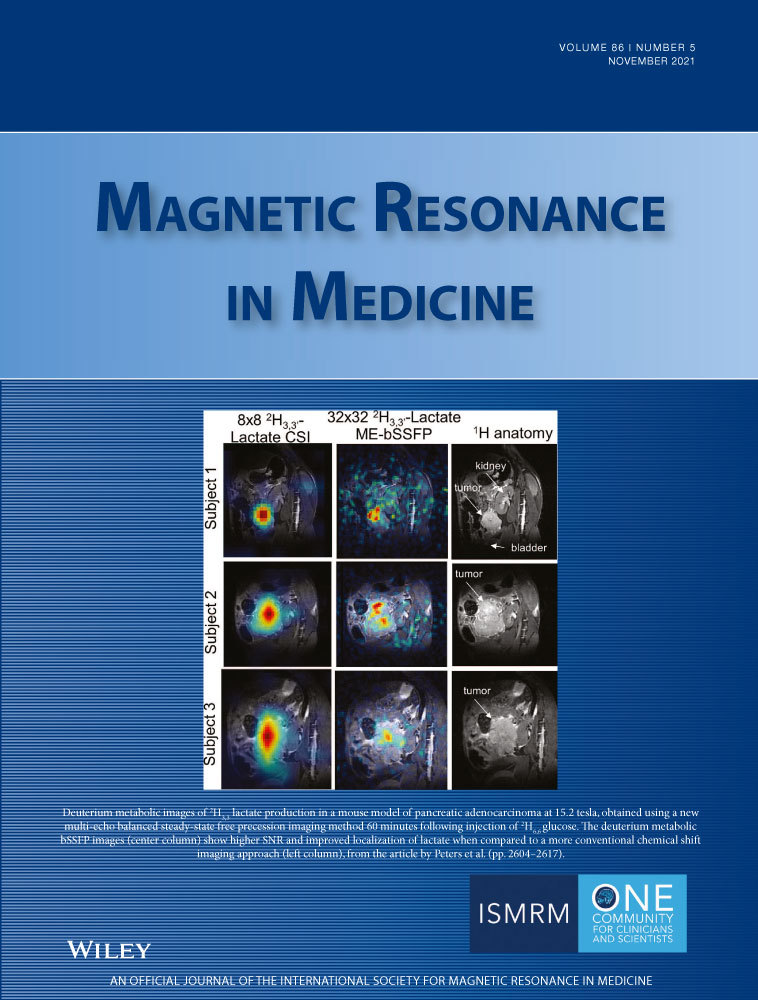Single-shot pseudo-centric EPI for magnetization-prepared imaging
Funding information
National Research Foundation of Korea (NRF-2020R1A2C2008949 and NRF-2020R1A4A1018714) and Korea Health Industry Development Institute (KHIDI) (HI19C0149)
Abstract
Purpose
To implement a single-shot centric-reordered EPI (1sh-CenEPI), which reduces TE significantly, thus enabling to improve SNR for magnetization-prepared imaging.
Methods
We proposed a 1sh-CenEPI in which grouped oscillating readout gradients, phase-encoding blips within each group, and big phase-encoding jumps between two consecutive groups are incorporated to encode whole k-space from the center to the edges in a single shot. The concept was tested on phantoms and human brains at 3 T. In addition, the proposed reordering scheme was applied to pseudo-continuous arterial spin labeling for evaluating the efficiency of the centric reordering in magnetization-prepared imaging.
Results
The proposed 1sh-CenEPI reduced TE from 50 ms to 1.4 ms for gradient-echo EPI, and from 100 ms to 7 ms for spin-echo EPI, while the elongation of readout duration was below 10% of the whole readout duration in most cases. The 1sh-CenEPI images exhibited no distinct geometric distortion both in phantom and human brain, comparable to the conventional two-shot center-out EPI. In pseudo-continuous arterial spin labeling results, 3-fold temporal SNR increase and 2-fold spatial SNR increase in the perfusion-weighted images were achieved with 1sh-CenEPI compared with the conventional linear ordering, whereas the cerebral blood flow values were consistent with previous studies.
Conclusion
The proposed 1sh-CenEPI significantly reduced TE while maintaining similar readout window and providing images comparable to the conventional linear and multishot center-out EPI images. It can be a qualified candidate as a new readout for various magnetization-prepared imaging techniques.
6 CONFLICT OF INTEREST
The authors have no conflict of interest to declare



 decay and off-resonance (B0 inhomogeneity). A, Magnitude of point spread function (PSF) of delta function with
decay and off-resonance (B0 inhomogeneity). A, Magnitude of point spread function (PSF) of delta function with  decay under various N values. B, Effect of phase-encoding ordering on Shepp–Logan phantom image due to
decay under various N values. B, Effect of phase-encoding ordering on Shepp–Logan phantom image due to  decay. C, The evolution of signal intensity along the phase-encode (PE) direction due to
decay. C, The evolution of signal intensity along the phase-encode (PE) direction due to  decay. D, Magnitude of PSF under on/off-resonance condition. In PSF simulation, the echo spacing,
decay. D, Magnitude of PSF under on/off-resonance condition. In PSF simulation, the echo spacing,  , and temporal delay due to big PE jumps were 0.1 ms, 30 ms (ie,
, and temporal delay due to big PE jumps were 0.1 ms, 30 ms (ie,  of gray matter at 3 T), and 0.04 ms, respectively, similar to the experimental condition. The FWHM of 1sh-CenEPI was wider than that of 1sh-LinEPI and increased with smaller N values: 0.0191 (linear), 0.0319 (N = 1), 0.0262 (N = 4), 0.0250 (N = 8), 0.0235 (N = 24), and 0.0215 (N = 48) (A) and Shepp–Logan phantom images showed consistent results (B). C, Although the signal decays mono-exponentially in 1sh-LinEPI, there were signal discontinuities in 1sh-CenEPI. D, The off-resonance induced only a unidirectional pixel shift along the PE direction for 1sh-LinEPI, whereas the peak was divided bi-directionally for 1sh-CenEPI and the shift was larger in smaller N values. The frequency offset for off-resonance condition was 40 Hz. It should be noted that the off-resonance effects shown in (D) can be resolved by the modified B0 map–based correction method that is proposed in this study
of gray matter at 3 T), and 0.04 ms, respectively, similar to the experimental condition. The FWHM of 1sh-CenEPI was wider than that of 1sh-LinEPI and increased with smaller N values: 0.0191 (linear), 0.0319 (N = 1), 0.0262 (N = 4), 0.0250 (N = 8), 0.0235 (N = 24), and 0.0215 (N = 48) (A) and Shepp–Logan phantom images showed consistent results (B). C, Although the signal decays mono-exponentially in 1sh-LinEPI, there were signal discontinuities in 1sh-CenEPI. D, The off-resonance induced only a unidirectional pixel shift along the PE direction for 1sh-LinEPI, whereas the peak was divided bi-directionally for 1sh-CenEPI and the shift was larger in smaller N values. The frequency offset for off-resonance condition was 40 Hz. It should be noted that the off-resonance effects shown in (D) can be resolved by the modified B0 map–based correction method that is proposed in this study
